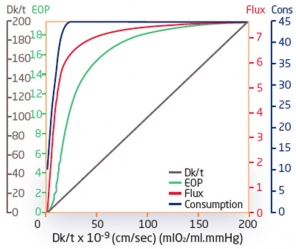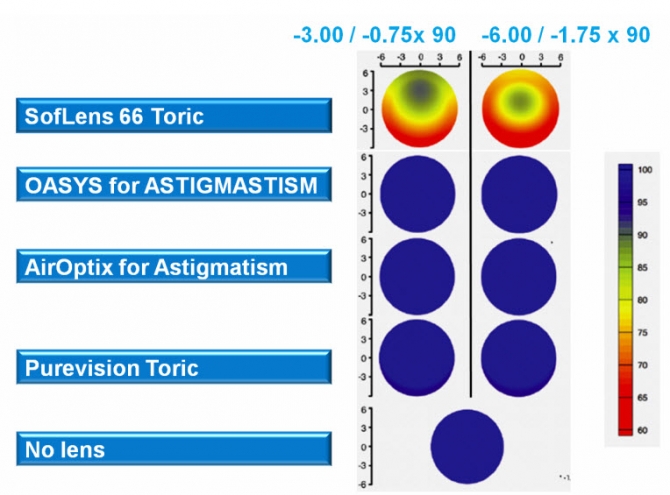Dk/t
Dk is a measure of the permeability of a material. To relate this to the oxygen performance of a contact lens, Dk is divided by t, the thickness, usually taken at the centre of that lens. This gives a measure of oxygen transmissibility that shows the amount of oxygen that can pass through a contact lens in air. The measure of Dk/t has been used as an industry standard for hydrogel contact lenses for more than 30 years.
While this measure is valid for hydrogel lenses, it is arguably no longer relevant where silicone hydrogels are concerned.1 Whilst it does describe the amount of oxygen passing through a contact lens in laboratory conditions, it does nothing to replicate the on-eye situation. A better understanding of alternative oxygen measurements such as oxygen flux and oxygen consumption shows that in these highly permeable materials, a doubling of the Dk/t does not result in a doubling of the oxygen delivery to the eye.1 Indeed, it is interesting to note that currently all silicone hydrogels produced since 1999 have a lower Dk/t than that original lens.
Read on to find out how both oxygen flux and consumption better describe the oxygen performance of silicone hydrogels.
Flux
The measurement of oxygen flux takes a step further than Dk/t by calculating the amount of oxygen that passes through a lens on the eye and enters the cornea. As such it attempts to better describe the on-eye situation of a contact lens. An eye wearing no contact lens would have an oxygen flux of 100% with a normal amount of atmospheric oxygen being able to enter the eye.
The amount of oxygen that can enter the eye has a natural upper limit due to the partial pressure of oxygen in the atmosphere. This is 159mmHg at sea level.1 It is because of this, that beyond a certain level doubling the Dk/t does not lead to a doubling of oxygen entering the eye. This is called the law of diminishing returns and is illustrated in the graph. In fact, moving from a Dk/t of 60 to one nearly three times greater of 175 only results in an extra 3% of oxygen entering the central cornea.1

Dr Philip Morgan speaking about oxygen transmissibility and oxygen flux.
Read the clinical paper here - Brennan, N and Morgan, P. Part I: Clinical Highs and Lows of Dk/t. Has oxygen run out of puff? Optician, 2009.
1. Brennan, N and Morgan, P. Part I: Clinical Highs & Lows of Dk/t. Has oxygen run out of puff? Optician, 2009, Vol 238, No 6209, 16–20.
Consumption
While oxygen flux does a better job of illustrating the amount of oxygen entering the anterior cornea, it still falls short as a measure of corneal metabolism because oxygen can also enter through the posterior cornea.1 It is important to be able to model corneal metabolism to understand the amount of energy that the cornea is generating to carry out its normal functions. The amount of oxygen available for these processes is the rate limiting step1 and so by understanding the oxygen consumption needs of the cornea, we can in turn understand if a contact lens placed on its surface is compromising that process or not.
The work of Professor Noel Brennan shown here depicts the results of this corneal modelling as a colour map. Where no lens is worn and hence no compromise to corneal oxygenation is present, the colour map is a uniform blue across the entire cornea. His results show, irrespective of Dk/t, prescription or design, all of the silicone hydrogel tested in the study provide adequate oxygen to the eye to enable it to continue to metabolise without compromise.
The learning from this work, and the point to remember when selecting a lens, is that all currently available silicone hydrogel contact lenses provide adequate oxygen to the eye for daily wear irrespective of their Dk/t.
Read on to find out more about the material properties of silicone hydrogels and how through better understanding of their contribution to contact lens comfort, the most appropriate contact lenses can be selected for patients.

Oxygen consumption plots for various toric soft contact lenses. Courtesy Professor Noel Brennan.
1. Brennan, N and Morgan, P. Part I: Clinical Highs & Lows of Dk/t. Has oxygen run out of puff? Optician, 2009, Vol 238, No 6209, 16–20.


